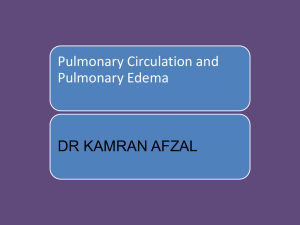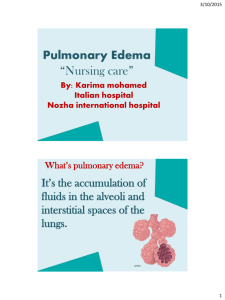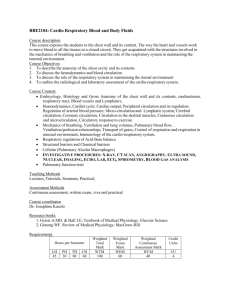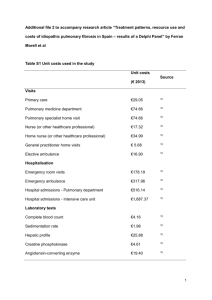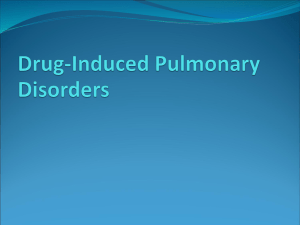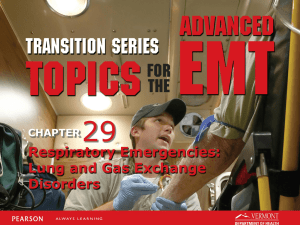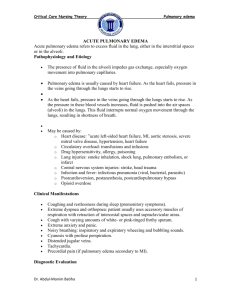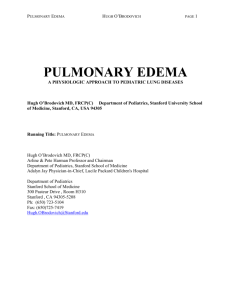Distribution
advertisement
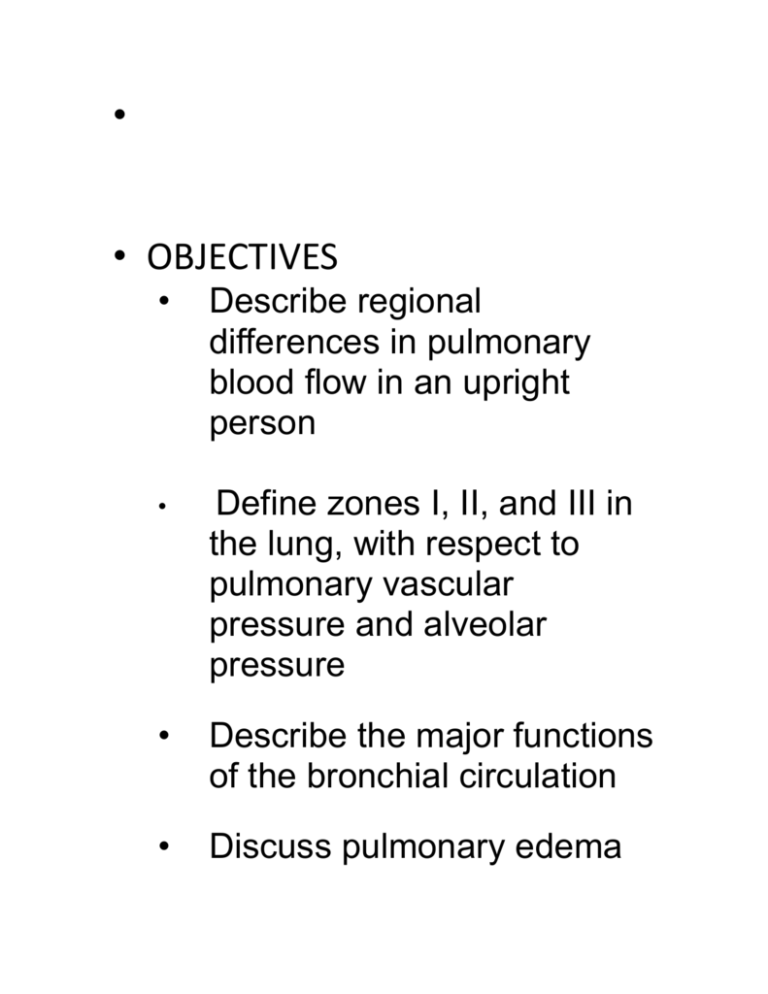
• • OBJECTIVES • Describe regional differences in pulmonary blood flow in an upright person • Define zones I, II, and III in the lung, with respect to pulmonary vascular pressure and alveolar pressure • Describe the major functions of the bronchial circulation • Discuss pulmonary edema • Identify Clinical Correlations • Distribution of blood circulation • 280 billion capillaries, supplying 300 million alveoli • Total volume of blood in all vessels • • man: 5.4 l (70-80 ml / kg) woman: 4.5 l (65-70 ml / kg) • Distribution: • • • Heart 7% Pulmonary circulation 9-10% Systemic circulation 84% • • • • from that veins 75% large arteries 15% small arteries 3% capilaries: 7% • Pulmonary Blood Pressures Gravity and Distance: – Distance above or below the heart (arterial ,venous) – Distance between Apex and Base • Pulmonary Capillary dynamics • Starling forces (ultra filtration) • • • • Capillary hydrostatic P = 7 mmHg. Interstitial hydrostatic P = -8 mmHg. Plasma colloid osmotic P = 28 mmHg. Interstitial colloid osmotic P = 14 mm • Filtration forces = 15 mmHg. • Reabsorption forces = 14 mmHg. • Net forces favoring filtration = 1 mmHg. • Excess fluid removed by lymphatics • 3 Zones . • 23 mm Hg pressure difference between top and bottom • At top, 15 mm Hg < than the PAP at the level of the heart • At the bottom, 8 mm Hg greater than the PAP at the level of the heart. • Regional Pulmonary Blood Flow Depends Upon Position Relative to the Heart • Gravity, Alveolar Pressure, and Blood Flow • Effect of hydrostatic P on regional pulmonary flow From apex to base capillary P (gravity) • The ratio of V/Q in lung at rest 0.8 (4.2 L/min ventilation divided by 5.5 L/min blood flow). • When the ventilation (Va) is zero, yet there is still perfusion (Q) of the alveolus, the Va/Q is zero. • at the other extreme, when there is adequate ventilation, but zero perfusion, the ratio Va/Q is infinity. • At a ratio of either zero or infinity, there is no exchange of gases through the respiratory membrane of the affected alveoli • Lung blood flow rises towards bases and also during Exercise • Double circulation in the respiratory system 1. Bronchial Circulation 2. Pulmonary Circulation 1. Bronchial - • • • Arises from L Ventricle.(systemic - oxygenated). 1-2% of left ventricular output. Supplies the supporting tissues of the lungs, including the connective tissue, septa, and bronchi. • Venous return from the bronchial by 2 routes. • bronchial drainage is into azygous (1/2) • 2.pulmonary veins (1/2) (short circuit • Pulmonary Circulation Arises from • Right Ventricle. • Receives 100% of blood flow. • Definition: • Pulmonary edema is a condition characterized by fluid accumulation in the lungs caused by back pressure in the lung veins. This results from malfunctioning of the heart. • Causes: • Pulmonary edema is a complication of a myocardial infarction (heart attack), mitral or aortic valve disease, cardiomyopathy, or other disorders characterized by cardiac dysfunction. • Pathophysiology: • Fluid backs up into the veins of the lungs. Increased pressure in these veins forces fluid out of the vein and into the air spaces (alveoli). This interferes with the exchange of oxygen and carbon dioxide in the alveoli. • Symptoms: • Extreme shortness of breath, severe difficult breathing • Feeling of "air hunger" or "drowning" • "Grunting" sounds with breathing • Inability to lie down • Rales • Wheezing • Anxiety • Symptoms: • Restlessness • Cough • Excessive sweating • Pale skin • Nasal flaring • Coughing up blood • Breathing, absent temporarily • Signs: • Listening to the chest with a stethoscope (auscultation) may show crackles in the lungs or abnormal heart sounds. • A chest x-ray may show fluid in the lung space. • An echocardiogram may be performed in addition to (or instead of) a chest x-ray. • Tests: Blood oxygen levels (low) A chest X-ray may reveal the following: Fluid in or around the lung space Enlarged heart • Tests: An ultrasound of the heart (echocardiogram) may reveal the following: Weak heart muscle Leaking or narrow heart valves Fluid surrounding the heart • Treatment: • This is a medical emergency! Do not delay treatment. Hospitalization and immediate treatment are required. • Oxygen is given, by a mask or through endotracheal tube using mechanical ventilation. • Expectations (Prognosis): • Pulmonary edema is a lifethreatening condition. It is often curable with urgent treatment and subsequent control of the underlying disorder. • Complications: • Long-term dependence on a breathing machine (ventilator)
